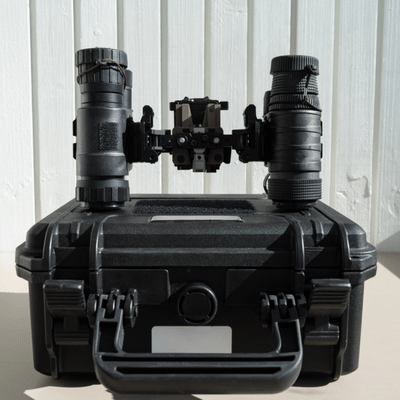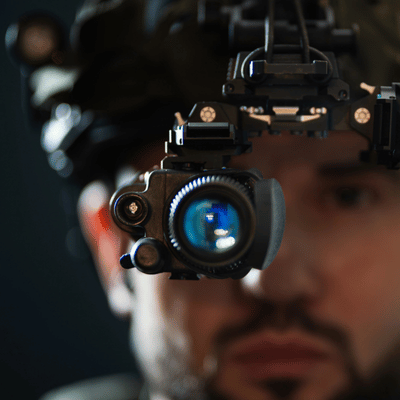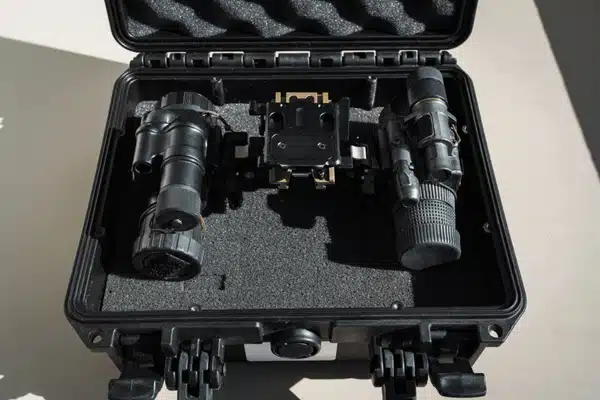Night vision goggles help pilots, law enforcement officers, and military personnel see clearly in dark conditions. These advanced technology devices turn ambient light into images and visible light that enhance visibility and even let users detect heat signatures. Yet storing night vision goggles improperly shortens battery life and can cause accidental damage.
Your night vision goggles contain delicate components like the image intensifier tube and phosphor screen, so proper care is critical. Always wipe lenses with a microfiber cloth, avoid exposing them to rough materials or extreme temperatures, and store with caps on to ensure optimal performance. Night vision goggles also need battery care; remove cells during long storage and regularly check contacts for corrosion.
Schedule regular maintenance to ensure optimal performance before each mission. By following these night vision goggles storage tips, you will keep ambient light converters ready when you need them and night vision goggles operational for years.
Why Proper Storage Matters for Night Vision Technology
Night vision goggles work by collecting available light and making it thousands of times brighter so the human eye sees a clear image even in total darkness. The intensifier tube inside your goggles contains sensitive parts that break easily; heat, moisture, and light conditions such as sudden exposure to bright lamps destroy these components quickly.
Military, security personnel, and law enforcement teams depend on reliable performance from their night vision goggles when operating in harsh conditions or total darkness. A broken device during search and rescue operations can put lives at risk. Wildlife observers and outdoor enthusiasts also need gear that withstands changing light conditions and keeps the infrared illuminator functioning.
Store your night vision goggles wrong and you will face blurry images, broken internal components, short battery life, and expensive repairs not covered by warranty. Always choose a cool, dry environment, remove dirt with a soft brush, store batteries separately to improve battery care, and follow manufacturer maintenance tips to keep your investment safe and working properly.
Use a Protective Case Every Time

Never leave your night vision goggles sitting loose on a shelf or in a bag. Always put them in their protective case when not in use. The case shields your device from damage, dust, and sudden temperature changes.
Put lens caps on before storing the goggles. These caps protect the lenses from scratches and block light from entering the device. Even when powered off, strong light can damage the sensitive parts inside.
Make this a habit after every use. Remove the goggles from your helmet mount, put on the lens caps, and place them securely in the case. This simple step prevents most storage damage.
Ready to protect your investment? Get a quality protective case designed for your specific night vision model today.
Store in Cool, Dry Places Away from Light
Environmental conditions make or break your night vision goggles. Understanding how night vision goggles work in low light environments and low light conditions helps preserve image clarity. Extreme heat or humidity ruins sensitive components, especially for military and law enforcement units and wildlife observation teams that rely on them in complete darkness.
Store night vision goggles between 32 °F and 100 °F year-round. Avoid hot trunks, damp basements, attics that swing, and areas with direct sunlight or bright lamps that could activate the infrared illuminator. Moisture invites fog, mold, and rust, all enemies of image clarity.
Use silica-gel packets in the case to maintain a cool, dry environment, then regularly inspect seals and note usage frequency as part of proper maintenance. Keep night vision goggles away from windows, heaters, and even lights because long exposure to low light conditions still stresses the intensifier tube. Remember low light environments such as moonless fields or ship decks.
For proper care follow these maintenance tips: store batteries separately, perform thorough cleaning after field use, and schedule annual service. With disciplined battery care and handling, your night vision goggles will stay mission ready and reliable.
Remove Batteries Before Storage

Leaving batteries in your night vision goggles during storage causes serious problems. Old batteries leak acid that eats away at the battery compartment and internal wiring, compromising night vision reliability. This damage costs hundreds or thousands of dollars to fix.
Take out all batteries after each use. Store them separately in a cool, dry place away from extreme temperatures and harsh conditions. This extends battery life and preserves night vision optics.
Before your next mission in complete darkness, regularly check the compartment for any signs of corrosion or buildup. Clean the contacts with a lint free cloth; never use abrasive materials that can scratch metal surfaces. Inspecting connections ensures the human eye receives a clear night vision image when seconds count.
Always use the right battery type for your device and consult the user manual for exact specifications. Using the wrong battery can damage electronics or prevent proper operation, leaving you without night vision capability in complete darkness.
Clean Your Goggles Before Storage
Dirt and smudges left on your night vision goggles can cause permanent damage. Salt, mud, and fingerprints contain chemicals that eat away at lens coatings over time. Regular cleaning before storage prevents this damage and keeps your image sharp.
Start by blowing off loose dust and dirt. Never rub particles against the lenses as this scratches the coating. Use a microfiber cloth designed for optics to gently wipe the lenses clean.
For stubborn spots, use a small amount of lens cleaning solution on your cloth. Never spray cleaner directly on the goggles. Avoid harsh chemicals like ammonia or acetone that strip away protective coatings.
Clean the body of your night vision device with a slightly damp cloth. Wipe down the compartment for the battery and any metal contacts. Make sure everything is completely dry before storage. If your device has an infrared illuminator, clean its lens with the same care as the main optics.
Keep your image crystal clear. Clean your night vision goggles properly before every storage session.
Handle with Care to Prevent Damage

Night vision goggles contain precision optics that require gentle handling. Sudden shocks, drops, or vibration can knock parts out of alignment or crack the intensifier tube.
Hold your device by the main body, not by the lenses or mounting brackets. When removing goggles from helmet mounts, support the weight with both hands.
Check that all adjustable parts are in their storage position before putting the device away. Fold any articulating arms and make sure nothing sticks out that could get bent or broken. Don’t stack heavy items on top of your storage case. Keep the case latched shut to prevent it from opening if dropped.
Protect your precision equipment. Handle your night vision goggles like the sensitive optical instruments they are.
Follow Your Manual and Schedule Professional Service
Every night vision device is different. Your user manual contains specific care instructions for your exact model. Read it carefully and follow all manufacturer’s guidelines for storage and maintenance.
Schedule regular professional inspections to catch problems early. Aviation night vision goggles require FAA-mandated inspections every 180 days. Even if you’re not flying, annual professional service helps maintain optimal performance.
Professional technicians can check internal alignment, replace worn components, clean internal optics, and test image standards. Never try to repair your night vision goggles yourself. The internal components are extremely delicate and often contain toxic materials. Leave repairs to certified technicians who have the right tools and training.
Don’t guess about maintenance. Follow your manual and schedule professional service to keep your equipment reliable.
Protect Against Light Damage

Bright light is the biggest enemy of night vision technology. The image intensifier tube amplifies any light thousands of times. Direct sunlight or powerful flashlights can instantly burn out the phosphor screen inside.
This damage happens fast and can’t be fixed. A few seconds of bright light exposure can destroy a device worth thousands of dollars. Manufacturers don’t cover this type of damage under warranty.
Always keep lens caps on when your goggles aren’t actively being used. Never turn on your device in daylight or under bright indoor lights. Even with protective features, your goggles can still suffer irreversible damage from light exposure.
Store your night vision goggles in dark places. If you must keep them in a lit area, make sure the case blocks all light from reaching the device.
One mistake with bright light can ruin your expensive equipment. Always protect your night vision goggles from light exposure.
Create a Storage Routine That Works
Good storage habits become automatic with practice. Develop a simple routine you follow after every use.
Check that your device is powered off completely. Put on all lens caps and protective covers. Remove the batteries and store them separately. Give the lenses and body a quick cleaning. Place the goggles securely in their case.
Store the case in your designated cool, dry, dark location. Mark your calendar for the next professional inspection or maintenance check. This routine takes just a few minutes but prevents most storage-related damage. Make it as automatic as checking your gear before a mission.
Start building better habits today. Create a storage routine and stick to it every single time.
When to Seek Professional Help
Some storage and maintenance tasks require professional expertise. Contact a certified repair facility if you notice fuzzy or distorted images, dark spots that don’t go away, flickering or unstable pictures, physical damage to the case or lenses, or battery compartment corrosion.
Don’t wait for small problems to become big ones. Early professional attention costs much less than major repairs or full device replacement.
Protect your investment and your safety. Get professional help at the first sign of problems.
Your Night Vision Equipment Investment
Proper storage extends the life of your night vision goggles by years. These devices help you complete critical missions in law enforcement, military operations, search and rescue, and wildlife observation. Taking care of them protects both your financial investment and your operational capability.
Follow these storage tips consistently and your night vision goggles will provide reliable performance when you need it most. Remember that good storage habits work together with regular professional maintenance to keep your devices working at their best.
The few extra minutes you spend on proper storage and care pay huge dividends in equipment reliability and image quality. Make these practices part of your standard operating procedures and enjoy clear vision in the darkest conditions for years to come.
Ready to maximize your night vision equipment’s lifespan? Start implementing these storage tips today and protect your valuable investment.

